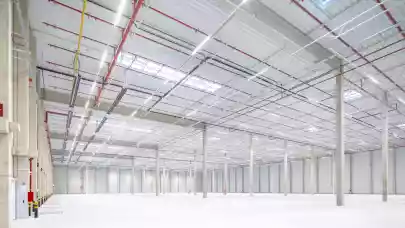
Utmost cautiousness, falling transaction volumes and waiting for the office sector to finally catch its breath and the large retail schemes to redefine their strategies contrast with considerable investor interest in specific retail formats, the dynamic growth of the logistics sector, and strong entry of European players onto the domestic residential rental market. This is what—according to the latest report by BNP Paribas Real Estate “At A Glance: Investment Market in Poland in Q2 2021”, Poland’s commercial property investment market looked like in the second quarter of the year.
Utmost cautiousness, falling transaction volumes, and waiting for the office sector to finally catch its breath and the large retail schemes to redefine their strategies contrast with considerable investor interest in specific retail formats, dynamic growth of the logistics sector, and strong entry of European players onto the domestic residential rental market. This is what—according to a latest report, Poland’s commercial property investment market looked like in the second quarter of the year.
The period between April and the end of June saw investors spend approx. €770 million on the commercial property investment market, which, compared to Q1 2020, translates into a 35% drop in transaction volumes. It is a slightly lower drop, i.e. by 30%, when we compare the last six months to the first months of the pandemic between January and the end of June in 2020 when social and economic restrictions were initially introduced.
"As far as the investment market is concerned, this current year is distinctively peculiar. It is difficult to compare it to last year when coronavirus struck, yet, in particular in the first few months, it was still possible to complete the transactions initiated prior to the outbreak of the pandemic. And it is still more difficult to find a common denominator for comparisons with the unrivalled 2019. When looking at what is shaping the reality of property investors today, it would be prudent to do it from an entirely new point of view. For the recovering market will be exercising caution and making more calculated investment decisions, on top of which there will be more scope for strategy revisions and increases in terms of results recorded, yet with different figures achieved for different types of products", says Mateusz Skubiszewski, Head of Capital Markets, BNP Paribas Real Estate Poland
The coronavirus pandemic has affected all sectors of the commercial property market, which has also had an impact on the investment segment. A lot of effort was made during that time to analyse the office sector to see how companies would be using office space in an attempt to adapt to the new reality and what new hybrid work strategies would be drawn up. The less than EUR 200 million spent on office transactions, with most of it in Warsaw, shows that the assessment of the medium- and long-term effect that the pandemic has had on the office sector will have to be postponed.
"Despite the fact that that changes on the office market are inevitable, the desire to return to normality, which includes returning to work at the office, has been growing stronger month to month. And this applies to both the hybrid model and working from the office full time. We anticipate for this trend to intensify as more and more people are getting vaccinated, thus enabling us to better control the COVID-19 epidemic", comments Małgorzata Fibakiewicz, Head of Business Intelligence Hub, BNP Paribas Real Estate Poland
The authors of the report at BNP Paribas Real Estate Poland point out that given the slowdown in terms of office investment and a more cautious approach taken by developers when it comes to starting new projects, with tenants remaining active and not moving away from working from the office full time in the future, a supply gap will appear. And its size will additionally be affected by the number of long-term transactions that have been suspended due to the health crisis.
The second quarter brought with it a revival of shopping centres following the easing of the fourth lockdown. Investors mostly had small retail parks and convenience centres in their sights during that time, thus generating a transaction volume of approx. EUR 100 million. The formats focusing on daily and convenient shopping were the ones to best cope with the changing shopping habits of the Polish population, additionally boosted by the coronavirus pandemic. The restrictions imposed on large schemes in the recent quarters have been reflected in a much lower interest displayed by market players in this format. The authors of the analysis agree that there are changes in store for shopping centres, and the transformation itself will be taking place on a mature and highly competitive market, promoting new functions, bold tenant-mixes, and an increased receptiveness to the omnichannel mode of operation and digitization.
The exit from Poland of the Tesco retail chain and the rumours concerning the Carrefour chain regarding the disposal of its assets in Poland mark a symbolic end of a certain stage in the commercial sector. The twilight of the hyper- and supermarket era opens the door for discounters and smaller chains, as well as e-commerce, which will ultimately translate into growth of smaller formats and logistics schemes focused on retail (to include the grocery segment).
According to the figures collected by BNP Paribas Real Estate, the largest volume of transactions completed in Q2 was recorded in the industrial and logistics sector. It amounted to approx. €470 million. Experts point out that the sector’s good shape and the positive prospects for the future become apparent when looking at the sustained dynamic pace of its growth, the stable and increasing demand, and the high developer activity. The positive sentiment on the industrial and logistics market is additionally supported by a number of long-term global changes occurring in, for instance, production structure and supply chains.
According to the report, as at the end of the second quarter, cap rates for prime office buildings remained unchanged at 4.70%. As far as industrial and logistics properties, cap rates for the period reported on are estimated at 4.50% for Warsaw and approx. 4.75% for the regional cities, while at the same time it is anticipated that they will become further compressed. This does not apply to properties occupied by e-commerce operators for which cap rates are estimated at 4.00–4.20%, where it is also expected that prices for these formats will continue to rise.
The second quarter was also crucial in terms of growth of the private rented sector. The interest shown in it by large players with extensive experience in investing in the PRS shows positive prospects for this market. The decision to buy apartments in Poland was first made by the Swedish housing operator Heimstaden Bostad, where a contract was signed with Budimex Nieruchomości to buy 2 500 units, which was soon followed by the Scandinavian real estate company NREP and its purchase of a portfolio of nearly 1 000 apartments of a total value of approx. €100 million to be constructed by the Finnish developer YIT.
"Despite the fact that the domestic institutional rental market is only taking its first tentative steps, the interest displayed by experienced and active European investors in the PRS indicates that they can see a lot of potential in Poland and are considering long-term commitment", said Anna Baran, Associate Director, Capital Markets, BNP Paribas Real Estate Poland



